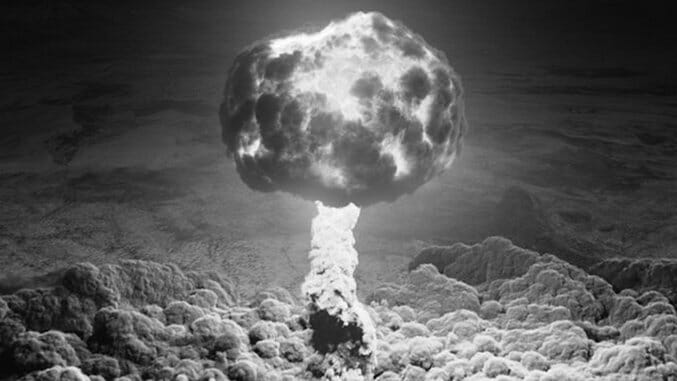
Episode VIII of Twin Peaks: The Return is the most experimental hour of the show yet, and never more than in this four-and-a-half minute montage of the Trinity nuclear test on June 16th, 1945. The sequence is a whiplash foray into abstract filmmaking, connecting the series’ supernatural horror to the destruction unleashed by the atomic bomb. It is also, perversely, the most backstory Twin Peaks has ever given viewers—in general narrative terms, we’re most likely watching the origin of BOB folded into the origin of the atom bomb—appropriately rendered in its most abrasive formal language to date.
The long camera move that brings us into the heart of the mushroom cloud is soundtracked by composer Krzysztof Penderecki’s 1960 “Threnody to the Victims of Hiroshima.” Laid over an image of roiling nuclear fire, the jagged, semi-improvised chaos of Penderecki’s score gains renewed ferocity—locking into its spiritual context. When Lynch’s camera enters the cloud, Penderecki’s music becomes almost diegetic, blending seamlessly with the sequence’s sound design.
Here, the image melts into pure texture. The flickering pointillism of this section recalls Man Ray’s silent 1923 Le retour a la raison (“Return to Reason,” an ironic phrase in this context), which cuts together direct animation, photograms and live-action footage before resolving into a shot of light playing across a woman’s bare torso.
Like the Man Ray piece, and experimental film in general, Lynch’s montage pulls together a cluster of disparate footage, such as backlit debris flying through the air (sort of Lynch’s own Kirby Krackle, an effect that dates back to Eraserhead) and what appear to be swarming low-poly CG shapes, in keeping with The Return’s embrace of often jarring, distancing digital effects. And it’s impossible to understate the importance of sound to this sequence on every level, from emotional repercussions to thematic coherence. It is wordless, but it is hardly silent.
Shows like Legion and Hannibal and The Leftovers cop stylistic moves from Blue Velvet and Mulholland Drive, which understandably led to some trepidation about what Twin Peaks would look like in 2017. It frankly diminishes Lynch’s work on this episode to say it’s unlike anything else on TV, or even in mainstream film, because it is a syncretion of Lynch’s entire career as an artist. It feels as alien to watch “on TV” in 2017, episode-by-episode, as Twin Peaks ’90 must have felt at the time. It’s clear no one expected what the show has delivered so far.
The Return is a spiritual cousin to the Pennsylvania Academy of Fine Arts’s 2014-15 exhibition David Lynch: The Unified Field, which showcased an array of large-format mixed-media paintings, charcoal drawings and short films. Lynch’s unique position as the most visible surrealist since Salvador Dalí means his art reaches far beyond the cadre of critics and audiences conversant in this kind of work, and his films have largely negotiated that terrain with grace. But The Return is unapologetically his in a way few artists ever manage to achieve; Lynch has both the money and the latitude to etch his ideas directly on-screen.
That said, it is still narrative TV; it is not pure abstraction. But the rhythm of it, what Vadim Rizov at Filmmaker Magazine acutely calls Lynch’s exploration of a “different kind of durational filmmaking,” is wildly different from the soap-opera pace of the original show. That durational style isn’t founded on long takes, à la Lav Diaz and Béla Tarr, but on “sustained moods” across the show’s 18 episodes. It’s as if a story that would take six hours to tell at a typical televisual clip has been stretched and pulled beyond recognition.
The Trinity sequence similarly dismantles the show’s logic, literally stripping it down to atoms, so that the rest of the episode can unfold in a void without even the few handholds (cutaways to familiar faces and the eternal struggle of Dougie-Cooper) established so far. Symbols are littered throughout—Lynch is careful to introduce us to a new vessel for the demonic BOB in the show’s opening before we see it again during the origin sequence—but without the expected expository tissue that even adventurous shows like The Leftovers provide.
Instead the episode offers images, like the walls of atomic fire that end the sequence, echoing the dissolve from the Great Northern Hotel’s waterfall to the rippling curtains of the Black Lodge in the series’ opening credits.
One image connects to another image to form an idea; atoms connect to atoms to form molecules. Hell is unleashed.